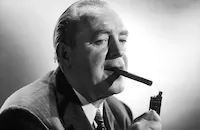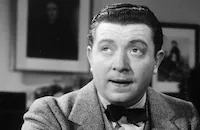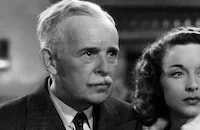Here Comes the Navy

Brief Synopsis
Cast & Crew
Lloyd Bacon
James Cagney
Pat O'brien
Gloria Stuart
Frank Mchugh
Dorothy Tree
Film Details
Technical Specs

Synopsis
While on a tour of the naval yard, officer Biff Martin gets into an argument with civilian iron worker Chesty O'Conner. Their quarrel escalates that evening at the iron workers' ball when Biff dances with Chesty's girl, Gladys Hawkins. Chesty loses his job as a result of their fight and decides to join the Navy in order to get even with Biff. After his ninety days training in San Diego, Chesty and his friend, Wilbur "Droopy" Mullins, are assigned to Biff's ship, the U.S.S. Arizona . To Chesty's disappointment, Biff informs him that all private fights must be postponed until they are ashore. In the meantime, Chesty has to follow Biff's orders as he is the senior officer. Biff's sister Dorothy comes aboard ship to visit her brother. Not knowing she is Biff's sister, Chesty decides to win Dorothy for himself. After learning that she works at the telegraph office, Chesty and Droopy visit there that evening, intending to wire Droopy's mother money for a new pair of false teeth. Dorothy invites Chesty to her apartment for a home cooked meal, and misunderstanding her intentions, Chesty makes a pass at her. She rebuffs him, and Chesty, who genuinely likes her, changes his attitude. While he is at Dorothy's, Biff walks in and throws him out. Biff then demands that Dorothy stop seeing Chesty, but she refuses, asking him instead to try to make friends with Chesty. When Chesty asks for special leave to visit Dorothy, however, Biff prevents it. Angrily, Chesty sneaks ashore in disguise, determined to quit the Navy. After Dorothy tells him she could never love a quitter, he returns to the ship, where he is court-martialed for being away without leave. The other sailors ostracize Chesty because of his attitude toward the Navy. When Dorothy defends Biff's actions, Chesty breaks up with her. Despite his dislike of the Navy, Chesty risks his life to put out a fire in the gunroom and receives a medal, which he does not take seriously. Finally the Navy transfers him to the dirigible field ashore. The dirigible is sent to San Pedro for Navy Day. While helping to land the air craft, Biff gets tangled in the ropes and is towed aloft. Chesty asks permission to rescue him, and when it is denied, he climbs down the rope anyway, parachuting to safety with Biff. Chesty and Dorothy are reconciled, and Biff gives the bride away when they marry. Chesty has the last laugh when he is promoted over Biff.

Director

Lloyd Bacon
Cast

James Cagney

Pat O'brien

Gloria Stuart

Frank Mchugh

Dorothy Tree

Robert Barrat
Willard Robertson

Guinn Williams

Howard Hickman

Maude Eburne

George Irving
Ida Darling
Henry Otho
Pauline True
Nick Copeland
Sam Mcdaniel
Frank La Rue

Joseph Crehan
James Burtis
Edward Chandler
Leo White
Niles Welch
Fred "snowflake" Toones
John Swor
Eddie Shubert
Edward Earle

Emmet Vogan
Martha Merrill
Lorena Layson
Crew
Charles Alexander
George Amy
Earl Baldwin
E. A. Brown
Al Cohn
Owen Crompton
Lou Edelman
Arthur Edeson
Sammy Fain
Leo F. Forbstein
Martin Glouner
Carl Guthrie
Esdras Hartley
Commander Herbert A. Jones
Irving Kahal
Clifton King
Keefe Malay
Ben Markson
Ben Markson
Orry-kelly
Bert Six
Joe Traub
Red Turner
Jack L. Warner

Videos
Movie Clip




Trailer
Film Details
Technical Specs

Award Nominations
Best Picture
Articles
Here Comes the Navy
The picture has good Hollywood credentials, too. Its stars are James Cagney and Pat O'Brien, making the first of their nine movies together they did seven more for Warner Bros. and then reunited for Ragtime in 1981, the last feature for both of them. Here Comes the Navy also scored a nomination for the Best Picture Academy Award, which it lost along with such other contenders as The Thin Man and The Gay Divorcee to It Happened One Night, a hard movie to beat.
Cagney plays Chester "Chesty" O'Conner, a can-do working guy who's getting through the Depression by working as a civilian riveter for the navy. There he runs afoul of Biff Martin, chief petty officer of the Arizona, played by O'Brien with just a smidgen less feistiness than Cagney displays. Their squabble turns into a brawl when they compete for a woman at a dance, and when Chesty loses the fight the lovely lady distracts him just as Biff throws his best punch the scrappy laborer sets his sights on revenge. This is easier said than done, since Biff immediately goes to sea, so Chesty does what any self-respecting movie character would do: He joins the navy, volunteers for the Arizona, and looks forward to decking his enemy.
Eventually the two meet again, but when Chesty prepares to give Biff what's coming to him, Biff informs him of something he should have learned in basic training: Officers rank higher than enlisted men, and if Chesty's fists fly, the rest of his body will land in the brig. Complicating things further, Chesty sees another alluring woman and falls so much in love that he can't give her up even when she turns out to be Dorothy "Dot" Martin, his enemy's loving sister. This sends all of them into a three-way feud, with Dorothy snagged between her sailor friend's wooing and her big brother's scolding.
Could things be any worse? You bet. Chesty sneaks off the ship to see Dorothy, and gets caught when he tries to sneak back on. Angry at being punished, he belligerently bad-mouths the navy, which shocks his shipboard buddies and turns them against him. Deciding he's beaten all around, Chesty slinks away and transfers from battleship duty to a dirigible unit. There he shows he's a trusty American after all, and everyone has a happy Hollywood ending.
In addition to the U.S.S. Arizona, parts of Here Comes the Navy were shot on location at real navy yards. The picture also shows maneuvers by the Pacific Fleet, and the climax -- when Chesty performs a daring rescue involving a dirigible trying to land at sea -- uses footage of the U.S.S. Macon, an American airship that was downed by a storm the following year, bringing an end to the military's experiment with lighter-than-air vehicles. The film's rescue scene is based on an actual incident two years earlier, when crewmen of the U.S.S. Akron held onto a blimp's ground ropes as it lifted into the air; the real-life accident killed two men, but this didn't stop Warner Bros. from transforming it into a chance for Chesty to save the day. Cagney did some of his own stunt work, burning his hands on a rope until they "looked like hamburger," as he described it later.
Along with its glimpses of armed-forces history, Here Comes the Navy reflects an interesting moment in Hollywood history: It was Cagney's first movie after the Catholic Legion of Decency gained censorship power in the industry, and Warner Bros. wanted to signal that the star's brash personality wouldn't be toned down as long as it kept selling tickets. That said, the movie struck some observers as unexpectedly subdued. In addition to laughs and authenticity, the reviewer for the New York Times praised it for having "the added advantage, in these parlous times, of being beyond censorial reproach." This was especially "remarkable" in a Cagney production, the critic continued, since his "rough-and-tumble antics in several earlier pictures" had been "held up to scorn by those who would reform the screen." While the star himself hadn't changed his style, the reviewer wrote, "the restraining hand of the producer, writer, director (or all three), never is relinquished."
The director who may or may not have restrained Cagney was Lloyd Bacon, whose most celebrated picture is 42nd Street, the popular Depression musical of 1933. That movie gains a lot of its pizzazz from the song-and-dance numbers staged by Busby Berkeley, and in Here Comes the Navy the military interludes serve a similar purpose, punching up a comedy-drama scenario that might easily run out of steam on its own.
The comedy episodes were enthusiastically received by the New York Times reviewer, who applauded some of "the heartiest laughs of the current cinema season" and called the finale, wherein a caterwauling old lady sings a wedding song from lyrics tattooed on her dopey son's torso, a "perfect comedy climax." Today's viewers won't be so tickled by such silliness, and it's painful to watch the movie's disgracefully racist material, as when Chesty puts on blackface so he can slip off the ship among African-American sailors going on leave. Like the battleship and dirigible sequences, these are best viewed as historical artifacts from America's not-so-distant past. Seen in this light, Here Comes the Navy has more to reveal than Cagney's talent for high-spirited hijinks.
Director: Lloyd Bacon
Screenplay: Earl Baldwin, Ben Markson
Cinematographer: Arthur Edeson
Film Editing: George Amy
Art Direction: Esdras Hartley
With: James Cagney (Chesty), Pat O'Brien (Biff), Gloria Stuart (Dorothy), Frank McHugh (Droopy), Dorothy Tree (Gladys), Robert Barrat (Commander Denny), Willard Robertson (executive officer), Guinn Williams (dance-floor manager), Howard Hickman (captain), Maude Eburne (Droopy's mother), George Irving (admiral).
BW-87m.
by David Sterritt

Here Comes the Navy
Quotes
Trivia
The movie was filmed in the spring of 1934 on the U.S.S. Arizona, which was sunk on 7 December 1941 at Pearl Harbor.
Notes
The film's pre-release title was Hey, Sailor. In the opening credits, the filmmakers acknowledge the cooperation of the Navy. The film was nominated for an Academy Award for Best Picture. According to contemporary sources, this movie was filmed on location at the dirigible field in Sunnyvale, CA, the Naval Training Station in San Diego, CA, the Navy yard at Bremerton, WA, in San Pedro, CA and on the U.S.S. Arizona. According to various news items in Hollywood Reporter, Margaret Lindsay was originally assigned to the lead, but when she could not continue because she had not fully recovered from appendix surgery, Ann Dvorak was considered before Gloria Stuart was finally cast. This was the first screen pairing of O'Brien and Cagney who went on to make eight movies together.















